Lasers and Metrology
Optical frequency metrology with frequency comb lasers (LaserLaB Amsterdam)
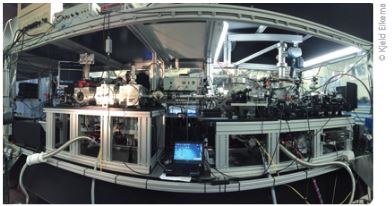
spectroscopy using light produced by High-Harmonic Generation.
Over the past two decades, optical frequency comb lasers have revolutionised the way in which coherent light is produced and characterised, from the far infra-red to the extreme ultraviolet (XUV). LaserLaB Amsterdam boasts a number of frequency comb laser systems, which form the core of experiments which measure the properties of calculable atoms and molecules with very high precision, thus enabling tests of the predictions of fundamental physical law at their very limits.
As a result of many years of development, including support from Laserlab-Europe through Joint Research Activities and access, optical excitation of atoms and molecules with coherent narrowband sources has been successfully applied to determine the structure and properties of systems such as helium atoms, hydrogen molecules, and their ionised counterparts. LaserLaB Amsterdam uses a number of advanced techniques to cool, store and manipulate these species under well controlled conditions based on laser cooling and trapping, ion traps, and the world’s first molecular fountain.
With these methods, a spectral resolution in excess of 1 part in 1012 is achievable, although several challenges need to be overcome. For example, leveraging the high potential precision requires optical frequency measure-ments achieving a similar level of accuracy. This is precisely what frequency combs provide: direct optical frequency measurements (at hundreds of terahertz), utilising the frequency comb as an optical ruler which is stabilised to an atomic clock for accuracy. This has enabled optical frequency measurements in helium and in neutral and ionised molecular hydrogen with a relative uncertainty down to 1 part in 1012, which have been used to put fundamental physics theories to the test, and to constrain possible ‘Fifth forces’ of nature.
Another challenge is presented by the atoms and molecules themselves, which often have transitions of great physical interest located in the VUV and XUV wavelength range. LaserLaB Amsterdam has developed a scheme which takes advantage of the short, intense pulses of the frequency comb laser, and the exquisite control it offers over the optical phase, to up-convert these pulses and use them to directly excite atomic and molecular transitions with a new form of differential Ramsey spectroscopy in the hitherto difficult to access VUV and XUV domain.
Last but not least, LaserLaB Amsterdam has been developing methods to distribute the high optical frequency accuracy and stability of its laser sources to other facilities through telecom opti-cal fibre, and also to provide access to even more accu-rate atomic clock reference signals from national metrology institutes through the optical fibre network.
Jeroen Koelemeij, Hendrick Bethlem, Wim Ubachs, Kjeld Eikema (LaserLaB Amsterdam)
L.S. Dreissen et al., Phys. Rev. Lett. 123: 143001, 2019
Ultrashort pulse metrology using TERMITES and INSIGHT (LIDYL, France)
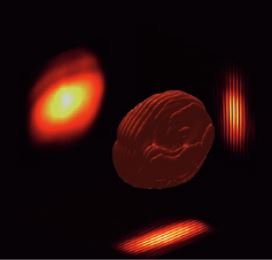
100 TW-25fs laser beam. photo:LIDYL
Full spatio-temporal characterisation of ultrashort la-ser pulses is difficult because the beam’s spatial properties are frequency dependent. Two new measurement techniques, TERMITES and INSIGHT, have been developed at the Laboratoire Interactions, Dynamique et Lasers (LIDYL, Paris-Saclay) to overcome this problem and were recently used to fully characterise the powerful femtosecond laser BELLA at Lawrence Berke-ley National Laboratory (USA).
Traditional characterisation routines for ultrashort lasers generally combine accurate determination of the tem-poral pulse profile with advanced diagnostics to measure the spatial properties, such as wavefront sensors. These routines, however, are totally blind to chromatism, i.e. a frequency dependence of the beam’s spatial properties, which can easily arise in ultrashort laser beams – as in any broadband light source. They therefore omit some crucial properties of these advanced light sources.
At LIDYL, two new characterisation techniques, TERMITES and INSIGHT, have been developed in the past five years to address this issue in a relatively straightforward way. So far, these techniques have been applied to more than fifteen laser sources, where they have systematically revealed undetected features. They have in particular provided the full spatio-temporal characterisation of one of the most powerful femtosecond lasers in operation to date, the BELLA laser at LBNL (USA).
One of the major difficulties of this advanced metrology of ultrashort lasers is that one needs to measure information in a 3D space (two spatial coordinates across the laser beam, and time or frequency), while available light sensors are still mostly two-dimensional. Both TERMITES and INSIGHT solve this issue by using spatially-resolved Fourier-Transform spectroscopy to obtain spectrally-resolved information at each pixel of a 2D camera.
In TERMITES, this approach is used on collimated beams to compare, in the spectral domain, each point of the test beam to a reference beam, which is created by spatially expanding a small portion of the test beam. In INSIGHT, it is used on a focused beam to measure the frequency-resolved spatial intensity profile of the beam in different planes along the propagation direction. An iterative phase-retrieval algorithm is then applied separately at each frequency to these sets of multiple beam profiles, to determine the spectrally-resolved beam wavefront. With both techniques, after an additional temporal measure-ment at a single point of the beam for phase stitching along the frequency axis, the laser field is totally reconstructed, either in space-time or space-frequency, and can then be numerically propagated in any plane.
Fabien Quéré (LIDYL)
A. Jeandet et al., J. Phys. Photonics 1: 035001, 2019
In-situ focal spot metrology (CLPU, Spain)
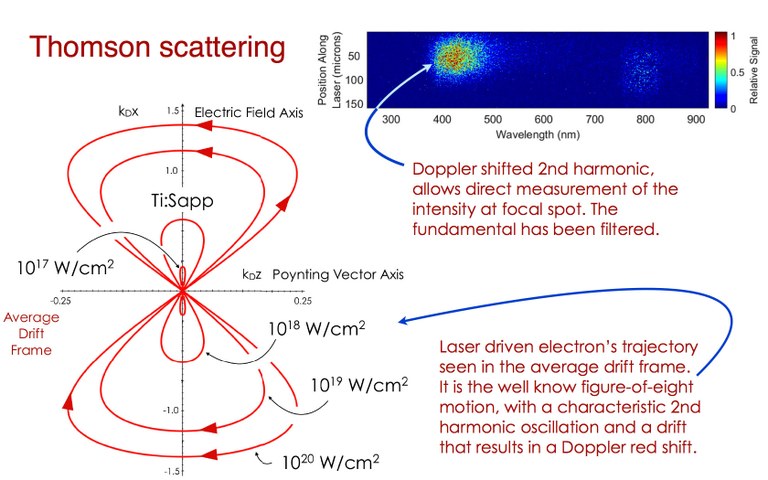
In many labs, laser pulses reach relativistic intensities today, precluding direct measurements of the focal spot with detectors because these will be damaged. At the Salamanca Pulsed Lasers Center (CLPU) a new method has now been tested, which allows direct measurement of the focal spot using Thomson radiation from free electrons present in the beamline.
At relativistic intensities (above 1018 W/cm2) it is impossible to place any detector just at the focus because it is going to be destroyed at each laser shot. So all the ways to measure the focal spot are based on indirect measurement, at full power, or extrapolations of the low power measurements; in either situation the measurement is indirect.
Recent experiments performed with the CLPU’s VEGA laser, in collaboration with the universities of Maryland and Alberta, show a direct way to measure relativistic intensities at focus. The underlying idea is very simple: at such intensi-ties all atoms are ionised and only free electrons and ions remain, which can be used as detectors. Even at 10-6 mb, the standard pressure in many experiments with petawatt lasers, there are a few atoms remaining in the focal volume. Moreover, the introduction of some extra gas (N2) at levels of 10-4mb does not modify the shape of the focal spot.
At relativistic intensities, ionised electrons oscillate due to the laser fields and radiate due to the relativistic behaviour in higher harmonics of the laser frequency, a process called Thomson scattering. Because the electrons move along the direction of laser propagation they experience a strong Doppler red shift. All this radiation is strongly linked to the laser intensity, so Thomson radiation is a valuable tool to measure the focal spot intensity in-situ.
As intensity increases electrons become too relativistic, rendering the measurement a bit too complicated. How-ever, at the ultrarelativistic limit (I>1024 W/cm2), where not only the electrons but also the protons are moving relativis-tically, the method can be applied again using the Thomson radiation pattern coming from the protons/ions. Therefore, this method is not only useful at present, using radiation scattering from laser-driven electrons, but also in the future, when scattering from laser-driven protons can be employed. To our knowledge, this is the first tool ever prepared to measure the ultrarelativistic laser frontier in-situ, suitable for the foreseen exawatt laser projects.
Luis Roso (CLPU)
C.Z. He et al., Optics Express 27: 30020, 2019
Large optics metrology for the LMJ facility (CESTA, France)
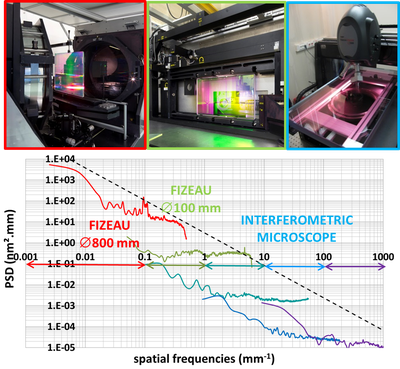
spatial frequency spectrum: Ø 800 mm and Ø 100 mm Fizeau
interferometers and interferometric microscope. The chart below
shows typical power spectral density (PSD) measurements to
illustrate sensitivities and spatial frequency ranges of these
instruments.
The high power laser facility Laser MégaJoule (LMJ) near Bordeaux employs thousands of meter-sized optical components, which all have to fulfill strict quality requirements. The optical metrology laboratory of the Centre d’Etudes Scientifiques et Techniques d’Aquitaine (CEA-CESTA) has developed a wide set of metrology in-struments specific to these large optics.
At the time of writing, LMJ is operating 48 laser beams arranged in 6 bundles. Each 400x400 mm2 beam can typically provide 3.5 kJ in a 3 ns pulse at 351 nm. LMJ is designed to accommodate 176 such beams. Each beam needs around 40 large optical components (up to 800x400 mm2): laser glass amplifier slabs, polarisers, spatial filtering lenses, frequency doubling/tripling KDP crystals, dielectric mirrors, gratings, vacuum windows, phase plates, etc. This adds up to thousands of meter-class optics that need to be perfectly qualified.
These components are manufactured all around the world. In order to make sure they fulfill our requirements once equipped on the laser beams and to ensure smooth operations between our different vendors, we have to rely on an undisputable metrology. In the early stages of the project, an optical metrology laboratory was created by the French Alternative Energies and Atom Energy Commission (CEA) to help accomplish all the steps of the construction of this laser.
Over the past two decades, we have developed, quali-fied and operated a wide set of instruments which enables us to monitor a high standard laser component production flow. These instruments are unique and specific to the size of the optics we want to control. We usually divide our measurements into four fields of expertise: surface imperfection inspection, photometry, laser induced damage measurement and wavefront measurement. They monitor the main specifications at all steps of an industrial manufacturing process able to produce hundreds of large optics a year. More details can be found in the reference.
Stéphane Bouillet (on behalf of the optical metrology team, CEA-CESTA)
S. Bouillet et al., J. Opt. Soc. Am. A 36: C95, 2019
Laser-induced damage threshold metrology of 3D microstructures (VULRC, Lithuania)
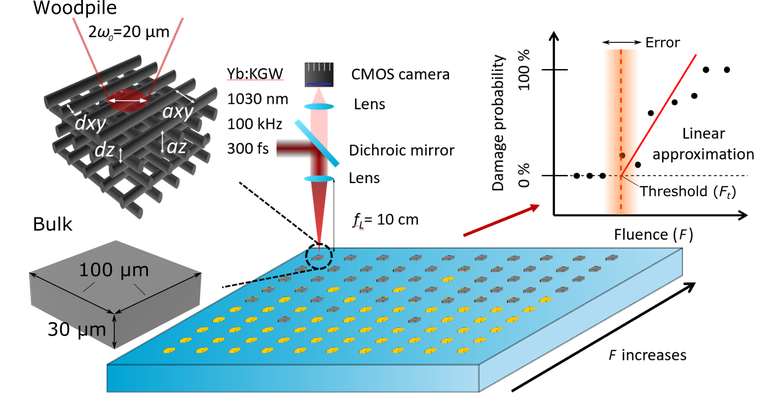
exposed to 1030 nm, 100 kHz, 300 fs laser radiation. Both woodpiles and bulks were
100 μm x 100 μm x 30 μm in size, with the woodpile being arranged in fcc geometry.
Each woodpile was also characterised by line width dxy, distance between them axy and
period az. Fluence was changed from line to line, from no damage to all structures being
damaged. This allowed to plot damage probability as a function of fluence and a linear
approximation was then used to determine its value.
Three-dimensional microstructures are already widely used as micro-optics, but for applications at high light intensities, detailed knowledge is required of their laser induced damage threshold. At the Vilnius University Laser Research Center (VULRC) the damage threshold of bulk and woodpile structures of various materials has recently been measured in detail for the first time.
Two-photon polymerisation (TPP), also known as multi-photon lithography, has been established as a pre-cision 3D printing technique allowing rapid fabrication of micro and nano-scale 3D objects. One of the key areas of the technique is the production of micro-optics. While they are already widely used for imaging and spatial light modulation, in order to implement these components also in applications where high light intensities (>GW/cm2) are used (non-linear microscopy, optical tweezing, materials processing), it is important to evaluate their laser-induced damage threshold (LIDT). Some preliminary studies have been carried out in this direction already, but these either used thin films, which are structurally completely different to TPP made objects, gave only qualitative guidelines, or had low practical value.
Therefore, TPP microstructures fabricated using different polymers and writing schemes were tested at VULRC to uncover trends in LIDT values. The tests were performed using the ISO S-on-1 method with femtosecond laser pulse trains. This method delivered statistically determined LIDT values, as well as damage morphologies. A representation of a typical LIDT experiment is shown in the figure. TPP microstructures are exposed to the focused laser beam one by one. Each row of the 10 x 10 microstructure arrays is exposed to a different la-ser fluence for one minute. After all microstructures are irradiated, the sample is examined by scanning electron and optical micros-copies to evaluate which mi-crostructures are damaged and which ones are not. This allows statistically reliable evaluation of the damage threshold of TPP-made objects.
Both bulk and woodpile structures were tested in this study. It was shown that the laser-induced damage threshold severely depends on the material (organic vs hybrid) and its composition (photosensitised vs without pho-toinitiator), with hybrid organic-inorganic photopolymers clearly outperforming the rest of the materials tested. The best performing 3D laser lithography made structure in this study was bulk made out of SZ2080 without photoinitiator with a LIDT value of 169 mJ/cm2.
Linas Jonušauskas (VULRC)
A. Butkutė et al., Optics Letters, ID: 378915, 2019
At-wavelength metrology of EUV and X-ray optics (LOA, France)
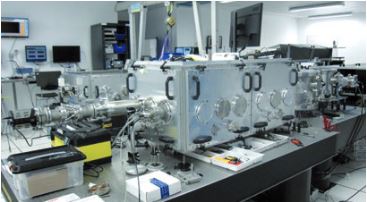
3 mJ, 30 fs Ti:Sa laser is shaped and focused in the black
box on the right. The small cylindrical chamber just behind
contains the gas cell for high harmonic generation, the
middle chamber holds a spectrometer while EUV optics are
tested in the rectangular, versatile and highly stable chamber.
An EUV wavefront sensor is attached to the chamber (left part)
as a key tool for optics metrology. photo: Philippe Zeitoun
At the Laboratoire d’Optique Appliquée (LOA, Paris-Palaiseau) metrology beamlines have been developed to test optical components for EUV and X-ray radiation. The equipment is ‘at-wavelength’, meaning that EUV or X-ray radiation is used to validate EUV or X-ray optical components, respectively.
Optical metrology is probably the most crucial step in optics fabrication; opticians tend to say that they are able to correct any defects they can measure. This might be true for visible optics, but metrology has always been a strong limiting factor for EUV (λ < 40 nm typically) and X-ray optics (λ < 0.1 nm typically). Here, optical metrology, i.e. using visible light, is not a viable solution considering the current and future requirements of EUV to X-ray optics for EUV lithography, spatial telescopes, synchrotrons and free-electron lasers. Therefore, a new paradigm is needed.
For about 15 years, we have been working at LOA in close collaboration with French manufacturer Imag-ine Optic to develop compact at-wavelength metrology beamlines that can be transferred to EUV and X-ray optics companies. In these beamlines, non-linear interaction of an intense, femtosecond laser with noble gas produces a high harmonic beam that is highly coherent, collimated, and – under specific conditions – diffraction-limited and thus perfectly adapted to perform at-wavelength EUV and X-ray metrology of optical components.
The beamline is equipped with an EUV spatial filter used to improve the high harmonic wavefront up to the required quality. Generally, the final wavefront reaches λ /50 rms with λ ≈ 30 nm, and recently we are pushing the performances to reach λ /100 rms. This corresponds to a wavefront of λ /1,000 rms to λ /2,000 rms when compared to the classical optical wave-length of 632.8 nm.
Metrology is performed using two wavefront sensors (one of low numerical aperture and one of high numerical aperture) developed by Imagine Optic, in collaboration with LOA and SOLEIL. So far, several optical components have been tested: from flat, spherical and toroidal mirrors to complex optics like Schwarzschild.
The combination of an achromatic sensor and high harmonic beamline also allows testing of attosecond mirrors. In addition, the beamline is used for research and development of EUV wavefront sensors, and the high degree of coherence of the beamline could be employed to quantify the surface roughness as well.
Today, LOA is exploring solutions to push the wave-lengths towards harder X-rays and to transfer the concept of this beamline to manufacturers of EUV and X-ray optics for the benefit of end-users.
Philippe Zeitoun (LOA)
P. Zeitoun et al., Proc. SPIE 10761: 107610G, 2018
Measuring the influence of the tempo-ral profile of laser pulses during target interactions (GSI, Germany)
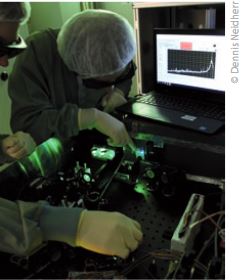
autocorrelator developed at PHELIX.
Ionisation of a target by laser light does not necessarily occur at the peak of the laser pulse. Therefore, precise knowledge of the temporal structure of the pulse is necessary to correctly interpret the experimental data created during the interaction of high-energy laser pulses with targets. For this reason, at the PHELIX facility of GSI Darmstadt new devices have been developed to characterise the temporal profile of such laser pulses, as well as to obtain information on the evolution of the target.
The standard diagnostic tool for high dynamic range temporal laser pulse characterisation is the cross-correlation technique. Unfortunately, the range in time and intensity necessary to characterise the newest high-temporal-contrast laser systems correctly has increased dramatically. At the PHELIX facility, however, a new device based on the cross-correlation concept shows that this technique can still fulfil today’s requirements. Foremost, we demonstrated that a variation of the geometry used for the interaction of the correlating beams reduces efficiently the signal noise. In addition, our calculations show that the dynamic intensity range of a cross-correlator increases with the interaction angle. In our realisation, the detection noise background was observed at 3.7×10−14 below the pulse peak intensity [1].
Complementary informa-tion on the target state (temperature, plasma scale length) can be ob-tained by time-resolved measurements and analysis of the back-reflected and transmitted light pulse after the interaction. For this purpose, we have developed a FROG pulse measurement de-vice with a dynamic range large enough to probe the target state, including the last moments of the rising slope of the laser pulse. Such a device can give a quite pre-cise measurement of the plasma expansion velocity, which is directly connected to the plasma temperature, while the pulse evolution at later times, closer to the intensity maximum, carries information on the plasma scale length. For thin targets, which can transmit a fraction of the laser pulse, a temporal analysis using Fourier-transform spectral inter-ferometry delivers other insights about the pulse intensity in the relativistic regime and the femtosecond electron dynamics after excitation by a high-intensity laser [2].
In our work, the laser is used in combination with very precise characterisation devices to explore the ultrafast dy-namics of petawatt laser pulses with matter, understand-ing of which is mandatory for efficient applications like hadron acceleration or laser-based X-ray generation.
Vincent Bagnoud, Johannes Hornung, Victor Schanz (GSI)
[1] V. A. Schanz et al., Optics Express 25: 9252, 2017
[2] V. Bagnoud et al., Phys. Rev. Lett. 118: 255003, 2017
All-optical, all-solid-state measure-ment of the waveform of ultrashort laser pulses (LLC, Sweden)
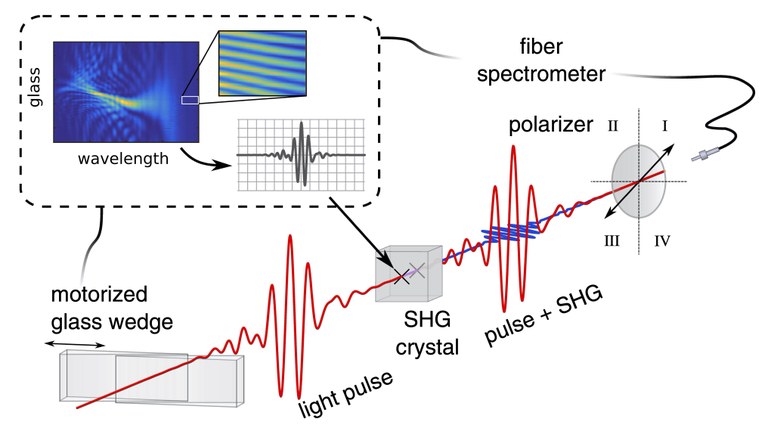
negatively chirped with chirped mirrors (not shown) and go through glass wedges
placed on a motorised stage. The pulses are focused on a thin second-harmonic
crystal followed by a polariser. The inset shows a typical d-scan trace
(second-harmonic signal as a function of glass insertion), a zoom of the trace in the
spectral interference region, and the corresponding reconstructed absolute optical
field at the entrance face of the crystal. Image taken from Miranda et al. (2019).
A new all-optical method for measuring the complete field of a light pulse in situ, including its absolute phase, has been developed by teams from Sweden’s Lund Laser Centre (LLC), Sphere Ultrafast Photonics (Porto, Portugal) and the University of Porto. This new method, published in the journal Optics Letters, shows promise for important applications of few-cycle laser pulses where knowledge of the absolute field of light is paramount, from light-controlled electronics in matter to high-harmonic generation and attosecond science.
Several techniques have been developed that provide access to the spectral phase of ultrashort laser pulses, yet lack information about the absolute electric field of light, i.e., the exact position of the carrier electric field within the laser pulse envelope, also known as the carrier-envelope phase (CEP). Even though there are presently several techniques capable of measuring the full electric field of light, they involve measuring photoelectrons or extreme-ultra-violet radiation under vacuum, and there is a limited choice of where the light field can actually be measured in space.
The new method devised by teams from LLC, Sphere Ultrafast Photonics and the University of Porto, is based on the dispersion scan (d-scan) technique, itself a new method for the measurement and compression of ultra-short light pulses. Of all pulse characterisation techniques, d-scan has the simplest optical setup, devoid of optical delays, beam splitting or recombination, and only requires measuring the spectrum of a nonlinear optical process produced by the light pulse (such as second-harmonic generation) as a function of dispersion applied to the same pulse. The resulting two-dimensional plot, or d-scan trace, enables retrieving the spectral phase of the pulses using a numerical algorithm.
By incorporating the CEP information contained in the d-scan trace directly in the pulse reconstruction algorithm, the teams managed to measure the complete electric field of a light pulse, including its absolute CEP in situ, using a purely optical and fully inline setup based only on second-harmonic generation in a standard nonlinear optical crystal. The technique was demonstrated for the case of a hollow-core fiber compressor, which is representative of state-of-the art systems currently used for high-harmonic generation and few-cycle electron acceleration experiments. This new technique could help closing the gap between emerging light-field-driven peta-hertz optoelectronics and existing waveform characterisation techniques, by enabling all-solid-state measurement of the driving optical waveforms on target.
Helder Crespo (University of Porto), Miguel Miranda and Cord Arnold (LLC)
M. Miranda et al., Optics Letters 44: 191-194, 2019

